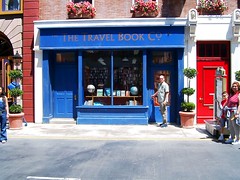Neighbourhoods blog and some gleanings
 Notting Hill bookstore featured in the Hugh Grant-Julia Roberts film. Photo from Tobias.
Notting Hill bookstore featured in the Hugh Grant-Julia Roberts film. Photo from Tobias.This blog is from the UK and I don't look at it as much as I should. Cyburbia has some sort of blog feed including his and mine, so I was reminded to check it out. Here's a posting, verbatim, about neighborhood commercial districts:
Today is High Street hype day - the All Party Parliamentary Small Shops Group is publishing its report today. [The report is actually here, but it's 91 pages and I'm not up to printing it off at the moment.]
Meanwhile, Sustrans have come up with a very neat coup by publishing (or re-publishing? I'm sure I've seen this before) a repeat of what was known as the Graz study, which showed how retailers under-estimate the importance of pedestrian travel and over-estimate the significance of cars. Sustrans researchers working in Bristol seem to have got very similar results. Their report is a model, lucid and concise.
"Retailers overestimated the importance of car-borne trade by almost 100%; they estimated that 41% of their customers arrived by car, whereas only 22% had done so. In fact, more than half of shoppers walked to the shops. Walking to neighbourhood shops, and meeting friends and acquaintances there, is an enjoyable social activity, as well as an efficient way of shopping."
"So the picture is of local shoppers, mainly walking to the shops, and visiting a number of stores. Interestingly, this is also a picture of healthy, physically active lifestyles, populous streets and informal contact with other local people. This is the picture that urban planners, public health specialists and community leaders want to see."
As an aside, I'm interested in the argument that "many shopping streets need wider pavements." It often feels like that, but I seem to think that William Whyte in his studies of New York street encounters (City, 1989) argued the opposite. "The highest incidence of encounters," he wrote, "is in the most crowded locations." Maybe we need to look at this again. Via.
I'm going to start checking in more diligently with this blog every couple days.
Index Keywords: civic-engagement; retail;



0 Comments:
Post a Comment
<< Home